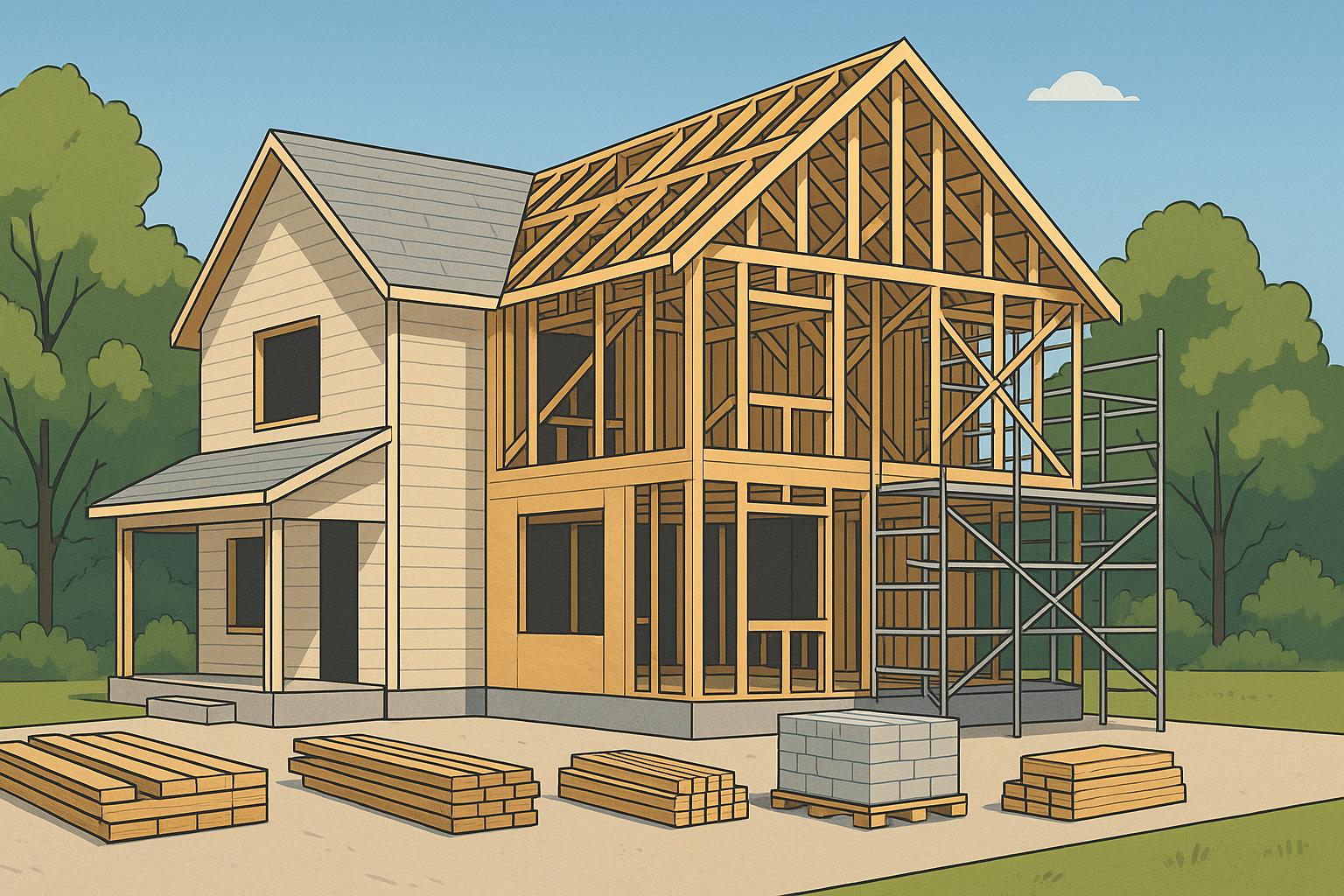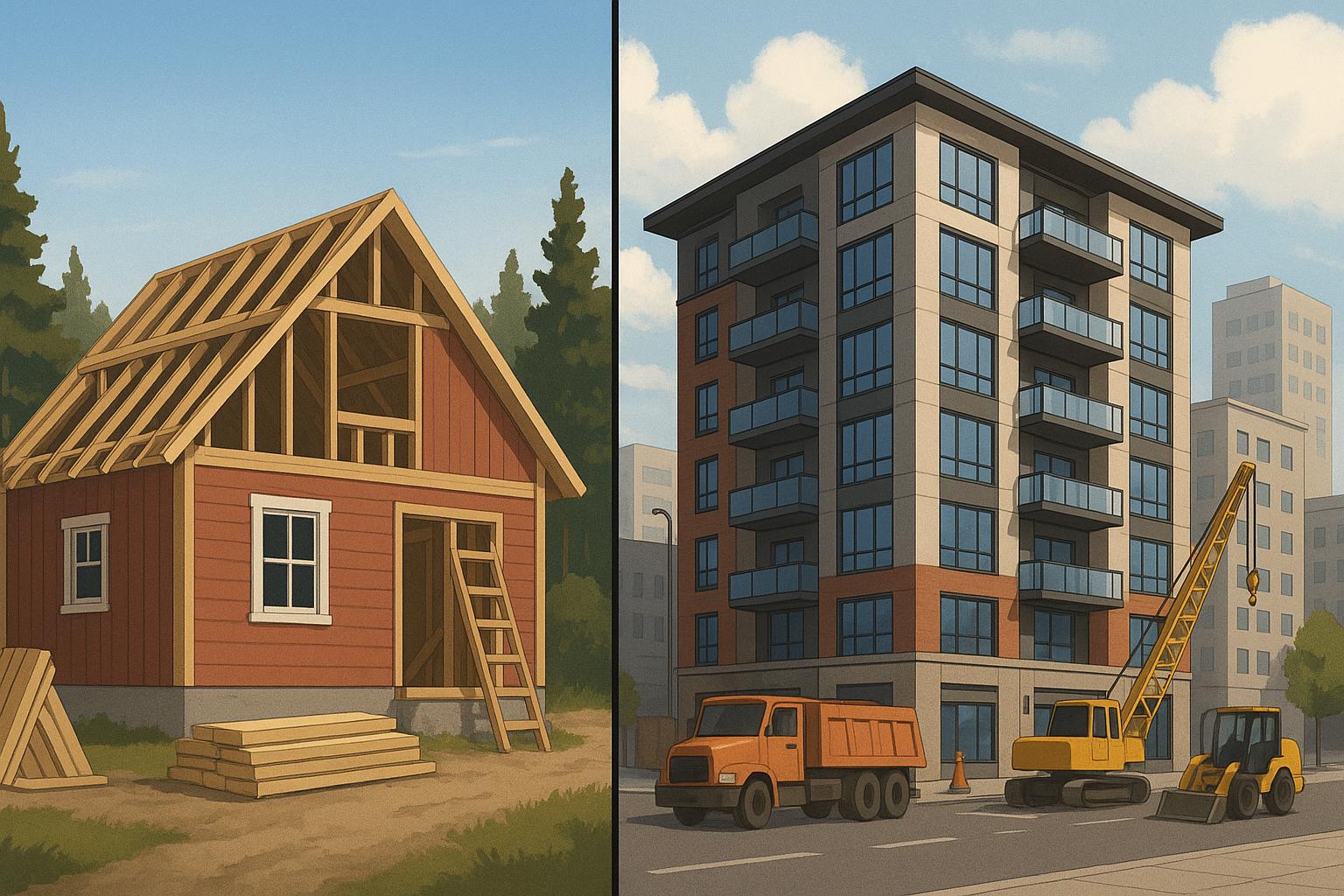Building a custom home in Nova Scotia requires careful planning and budgeting. Here’s a quick summary of what you need to know:
- Construction Costs: $150–$250/sq. ft. for a 2,000 sq. ft. home, starting at $168/sq. ft. for basic finishes.
- Land Costs: Urban Halifax lots range from $175,000–$450,000, while rural properties start at $45,000.
- Site Preparation: Includes land clearing ($8,000–$15,000), well systems ($10,000–$15,000), septic systems ($15,000–$20,000), and more.
- Soft Costs: Permits, surveys, and design fees add $15,000–$30,000.
- Contingency Fund: Set aside 5–10% of your budget for unexpected expenses.
Financing Options:
- Construction mortgages (funds released in stages)
- HELOCs (Home Equity Line of Credit)
- Private loans or government rebates (e.g., energy efficiency programs)
To save costs, consider pre-designed plans, energy rebates, and smart timing for construction. Plan for recurring expenses like loan interest, property taxes, and temporary housing during the build phase.
This guide will help you navigate costs, financing, and planning to build your dream home in Nova Scotia.
Nova Scotia Custom Home Cost Breakdown
Land Costs and Site Work
Land prices in Nova Scotia can vary greatly depending on the location. As of April 2025, here’s what you can expect:
- Urban Halifax lots: $175,000 to $450,000 for standard building lots
- Suburban areas (Bedford, Dartmouth): $125,000 to $275,000
- Rural properties: Starting at $45,000 for 1-acre lots
Preparing your land for construction involves several key costs:
| Site Work Component | Cost Range (CAD) | Notes |
|---|---|---|
| Land clearing | $8,000 - $15,000 | Depends on lot size and tree density |
| Excavation | $12,000 - $25,000 | Higher costs if bedrock is present |
| Well installation | $10,000 - $15,000 | Needed for rural properties |
| Septic system | $15,000 - $20,000 | Includes design and permits |
| Driveway | $5,000 - $12,000 | Gravel or asphalt options available |
Once the site work is complete, the focus moves to construction and materials.
Building and Materials Cost
The cost of building a home in Nova Scotia typically ranges from $150 to $250 per square foot, depending on the level of finishes. For a 2,000-square-foot home, here’s a breakdown of key expenses:
| Construction Component | Cost Range (CAD) | Percentage of Budget |
|---|---|---|
| Foundation | $45,000 - $65,000 | 15-20% |
| Framing and exterior | $85,000 - $125,000 | 25-30% |
| Roofing | $18,000 - $30,000 | 5-8% |
| Electrical systems | $25,000 - $35,000 | 7-10% |
| Plumbing | $30,000 - $45,000 | 8-12% |
| HVAC | $20,000 - $35,000 | 6-9% |
| Interior finishes | $65,000 - $120,000 | 20-25% |
Permits and Extra Costs
Soft costs, including permits and professional fees, are another important part of your budget:
- Building permits: $1,500 to $3,500
- Development permits: $500 to $1,500
- Architectural plans: $8,000 to $15,000
- Engineering reports: $2,500 to $5,000
- Land surveys: $1,200 to $2,500
- Legal fees: $2,000 to $4,000
It’s wise to set aside a contingency fund of 5–10% of your total budget. For example, on a $500,000 build, this would be $25,000–$50,000. This fund can cover unexpected issues like:
- Poor soil conditions
- Rising material costs
- Weather-related delays
- Changes to municipal requirements
- Design adjustments during construction
New Construction in Halifax Part One. How Much Does It Cost ...
Home Construction Financing Options
A well-thought-out financing plan is just as important as your detailed cost breakdown.
Construction Mortgage Basics
Construction mortgages in Nova Scotia work differently from traditional loans. Instead of receiving the full amount upfront, funds are released in stages as specific milestones are completed, like reaching the 'roof tight' stage or finishing drywall installation. The good news? Interest is only charged on the funds you've already used.
Most major Canadian lenders typically require:
- A detailed construction budget and timeline
- Valid building permits and plans
- Proof of builder's insurance
- A down payment (usually 20–25%)
- A property appraisal showing the value of the finished home
But construction mortgages aren’t the only option. Let’s look at some alternatives.
Other Ways to Finance Your Build
HELOC (Home Equity Line of Credit)
If you own property with equity built up, a HELOC can provide flexible funding. You only pay interest on the amount you withdraw, making it a practical choice for covering construction costs as they arise.
Private Construction Loans
Private lenders often offer faster approval and quicker access to funds. However, these loans usually come with higher interest rates and shorter repayment periods, so they’re best for short-term needs.
Government Programs
Nova Scotia offers several incentives that can reduce construction costs. These include rebates for first-time home builders, energy efficiency programs, and housing tax rebates.
Self-Financing Options
If you’ve saved a significant amount, you could use personal funds to cover land purchases, site preparation, or unexpected costs. Many builders mix personal savings with a smaller construction mortgage to keep borrowing - and interest payments - lower.
sbb-itb-16b8a48
Build Phase Cost Management
Monthly Expenses During Construction
During the construction phase, you'll need to budget for several recurring monthly costs:
Construction Loan Interest
- Interest payments will depend on the amount drawn, market rates, and the timing of your draws.
Property-Related Expenses
- Instalments for property taxes as required by your municipality
- Costs for builder's risk insurance
- Temporary site security measures or fencing, if necessary
- Fees for utility connections and ongoing usage
Temporary Housing Costs
- Local rental rates for alternative housing during construction
- Storage fees and transportation costs for site visits
Plan your finances by organizing a draw schedule and setting aside financial buffers to ensure smooth cash flow throughout the project.
Money Flow Planning
Tracking monthly expenses is just one part of the equation. A detailed money flow plan helps ensure your budget stays on track.
Construction Draw Schedule
Builders typically follow a staged draw schedule, which may include:
- Foundation work
- Framing and roofing
- Electrical, plumbing, and HVAC rough-ins
- Interior finishes
- Final project completion
The timing and amounts for each draw will depend on agreements with your lender and builder.
Managing Financial Buffers
- Keep an emergency fund covering about three months of expenses, in addition to your contingency fund.
- Align major purchases with draw payments for better cash flow.
- Delay non-essential upgrades until after the project is complete.
Practical Cost-Saving Tips
- Purchase materials during supplier sales or seasonal discount periods.
- Negotiate payment terms with vendors whenever possible.
- Look into cost-effective temporary housing options.
- Plan utility deposits and connection fees strategically.
- Keep detailed expense records for tax purposes and potential rebate claims.
Ways to Reduce Building Costs
Managing building expenses isn't just about knowing your costs - it's about finding smart ways to cut them down.
Pre-Designed Plans vs. Custom Designs
Using pre-designed plans can lower architectural and engineering fees while speeding up the construction process. For example, Helio Urban Development offers pre-designed homes starting at $168 per square foot, providing cost predictability and efficient layouts.
Advantages of Pre-Designed Plans:
- Efficient layouts designed to make the most of available space
- Lower design and engineering costs
- Faster approvals, thanks to pre-vetted plans
- Easier estimation of material quantities and costs
- Shorter construction timelines
These plans set the stage for further savings, which we’ll explore below.
Energy Savings and Rebates
Nova Scotia offers a variety of programs to support energy-efficient home construction, helping you save money in the long run.
Efficiency Nova Scotia Programs:
- New Home Construction Program: Provides rebates of up to $25,000 for energy-efficient builds
- Solar Homes Program: Offers rebates for installing solar panels
- Heat Pump Rebates: Up to $2,500 available for qualifying systems
While energy-efficient features may mean higher upfront costs, they can significantly reduce long-term expenses.
Next, let’s look at how timing and material management can further reduce costs.
Build Timing and Material Costs
Careful planning around when and how you build can make a big difference in your budget.
Best Times to Build:
- Winter builds often come with better contractor rates
- Off-season material sales can help you lock in lower prices
- Starting foundation work in early spring can avoid frost-related delays
Managing Material Costs:
- Secure fixed prices with suppliers early
- Buy materials in bulk to reduce costs
- Plan deliveries carefully to avoid unnecessary storage fees
Combining these strategies with fixed-price construction contracts can help you stay on budget and protect against unexpected price hikes.
Next Steps: Starting Your Build
With your cost breakdown and financing plan in place, it's time to prepare for your project.
Secure Your Financial Foundation
Get pre-approved for a construction mortgage by providing your budget breakdown, land details, and preliminary plans. Look into fixed-price options to lock in project costs.
Essential Documentation Checklist
Here’s what you’ll need to gather:
-
Property Documents
- Land deed or purchase agreement
- Property survey
- Soil test results
- Well and septic permits
-
Building Requirements
- Building permit application
- Site plan
- Construction drawings
- Energy efficiency compliance forms
-
Financial Papers
- Construction mortgage pre-approval
- Signed builder contract
- Cost breakdown
- Proof of down payment
Once you have all your paperwork ready, you can move on to organizing your schedule.
Plan Your Project Timeline
Work with your builder and local authorities to set clear milestones for permits and construction. This will help ensure everything runs smoothly from the start.
FAQs
How can I prepare for unexpected costs when building a custom home in Nova Scotia?
To prepare for unexpected costs during custom home construction in Nova Scotia, it's wise to set aside a contingency fund of 5–10% of your total budget. This helps cover unforeseen expenses like bedrock blasting during excavation or additional drainage on a wet lot.
Sticking to your original plan is another key strategy. Frequent design changes or upgrades can quickly inflate costs. Focus on investing in high-quality materials for critical areas, such as the structure and insulation, while opting for more budget-friendly finishes that can be upgraded later if needed.
By planning ahead and working with a knowledgeable builder, you can minimize surprises and keep your project on track financially.
What is a construction mortgage in Nova Scotia, and how can I prepare to apply for one?
A construction mortgage in Nova Scotia is different from a traditional home loan because funds are released in stages, called progress draws, as your custom home is built. These draws typically occur at key milestones, such as when the structure is roof tight or when drywall installation is complete.
To apply, you'll need a detailed budget and a signed contract with a registered builder, as most lenders require this to approve the loan. Be prepared to provide plans, permits, and cost estimates to demonstrate the feasibility of your project. Proper preparation ensures a smoother approval process and helps you stay on track financially during the build.
What are the advantages of choosing pre-designed plans over custom designs when building a home in Nova Scotia?
Opting for pre-designed plans can significantly lower architectural fees and reduce overall design costs. Since these plans are already developed, you avoid the time and expense of creating a custom design from scratch.
Pre-designed plans also streamline the building process, as they’ve typically been tested and optimized for efficiency and compliance with local building codes. This can lead to fewer delays and unexpected costs during construction. Additionally, they often include features tailored to Nova Scotia’s climate and lifestyle, offering a practical and cost-effective solution for many homeowners.



